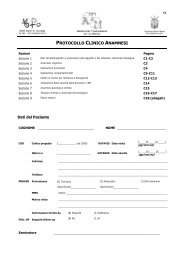Giovanni B Frisoni CURRICULUM VITAE - centro alzheimer
Giovanni B Frisoni CURRICULUM VITAE - centro alzheimer
Giovanni B Frisoni CURRICULUM VITAE - centro alzheimer
Create successful ePaper yourself
Turn your PDF publications into a flip-book with our unique Google optimized e-Paper software.
studies were aimed to standardize the then exquisitely subjective reading of imaging exams (e.g. #P28<br />
in AJNR) and use imaging tools to improve diagnostic accuracy (e.g. #P31 in JNNP and P46 in<br />
Neurology). On these issues, I was the pioneer in Italy and have summarized my achievements in the<br />
field of imaging with non computational tools in an editorial appeared in the JNNP (#E2).<br />
The “Alzheimer’s” period (late nineties to mid‐2000). In 1999, with the birth of the LENITEM, my<br />
scientific interests have veered more strongly towards the translational application of imaging<br />
techniques in the clinic. In the very early times of computational neuroscience, I have been the first in<br />
Italy to apply voxel‐based morphometry to neurological patients (#P79) and adopt the more<br />
sophisticated methods of cortical and hippocampal mapping (#R7 in Lancet Neurol, P127 in<br />
NeuroImage, and P141 in Brain).<br />
In this period, I have taken the lead of the Neuroimaging Interest Group of the EADC – European<br />
Alzheimer’s Disease Consortium and produced a European consensus document on the use of<br />
neuroimaging tools to rate key imaging features (#R8), brought the ADNI methods for multicentre MR<br />
image acquisition from the US to Europe (#P164), and investigated the diagnostic and therapeutic<br />
procedures of Italian dementia expert centres (#P177, P154, P133, P109, P87). Lastly, I have<br />
summarized the relevant advances in dementia research of the year 2006 in the January 2007 issue of<br />
The Lancet Neurology (#E6).<br />
In 2003 I have been appointed Scientific Coordinator of AFaR – Associazione Fatebenefratelli per la<br />
Ricerca. This is the scientific branch of the 25 Fatebenefratelli (Religious Order of St John of God) health<br />
services in Italy. My mission was to promote evidence‐based medical care in the pilot Fatebenefratelli<br />
hospital of San Maurizio Canavese, in the Turin area, where I have set up all the necessary procedures<br />
and trained personnel to the early diagnosis of Alzheimer’s and other cognitive disorders with the<br />
innovative use of imaging biomarkers (medial temporal and hippocampal atrophy based on high<br />
resolution MR). Since then, physicians in charge use hippocampal volumetry as part of their clinical<br />
assessment.<br />
The “European period” (late‐2000). From 2005, I decidedly entered the arena of European projects. I<br />
led my first FP project as a Principal Investigator in 2005 (ENIR – European NeuroImaging Repository,<br />
www.<strong>centro</strong><strong>alzheimer</strong>.it/ENIR.doc), aiming to develop the theoretical foundations for a Europe‐wide<br />
infrastructure capable of storing and processing a vast amount of brain imaging data with sophisticated<br />
computational algorithms. In that same year, talks were started between the European Alzheimer’s<br />
Disease Consortium and the US ADNI – Alzheimer’s Disease Neuroimaging Initiative (www.adni‐<br />
info.org) to explore the latitude for an extension of the ADNI to Europe, and I obtained funds from the<br />
US Alzheimer’s Association to carry out the Pilot European Alzheimer’s Disease Neuroimaging Initiative<br />
(pilot E‐ADNI) in 7 Alzheimer’s centres throughout Europe (http://www.<strong>centro</strong><strong>alzheimer</strong>.it/E‐<br />
ADNI_project.htm) in close connection with US ADNI.<br />
In 2008 I obtained a € 2.8 M funding from FP7 for neuGRID ‐ A Grid‐Based e‐Infrastructure for Data<br />
Archiving/Communication and Computationally Intensive Applications in the Medical Sciences<br />
(www.neuGRID.eu). The project successfully concluded in January 2011, creating the necessary<br />
conditions for two expansions: outGRID, a € 440 K project funded under EC FP7 (www.outGRID.eu)<br />
aiming to make neuGRID interoperable with homologous infrastructures in the US and Canada and<br />
neuGRID for users (N4U) which aims to provide neuroscientists with a Global Virtual Laboratory by<br />
further developing and deploying the neuGRID infrastructure. The long term vision is to develop the<br />
5




